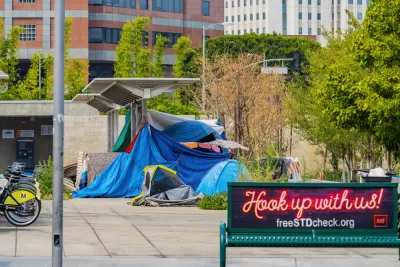An article by the L.A. Times earlier this week has raised the temperature of the debate about drug users and crime on rail transit. Concerns about public safety on transit are a common symptom of post-pandemic transit around the country.

“Since January, 22 people have died on Metro buses and trains, mostly from suspected overdoses — more people than all of 2022. Serious crimes — such as robbery, rape and aggravated assault — soared 24% last year compared with the previous,” according to an article by Rachel Uranga for the Los Angeles Times.
The article has been the talk of social media all week, with advocates and public officials weighing in on either side of the issue. The article suggests that ridership on the Los Angeles County Metropolitan Transportation Authority (Metro) is suffering as a result of the perceived public safety risks on the system—particularly on the system’s rail lines.
Commuters have abandoned large swaths of the Metro train system. Even before the pandemic, ridership in the region was never as high as other big-city rail systems. For January, ridership on the Gold Line was 30% of the pre-pandemic levels, and the Red Line was 56% of them.
Eventually, the article discusses the Ambassador Program, launched by metro at the beginning of March after being announced in June 2022:
In response to such concerns, transit officials committed $122 million over the last year trying to make the system — composed of 105 rail stations and more than 12,000 bus stops — feel safer by placing 300 unarmed “ambassadors” to report crimes and help passengers. It’s part of what officials like to tout as a “multilayered” approach to improving a system that’s become emptier and more dangerous over recent years — even as billions have been sunk into expansion of the rail lines.
The article also provides details about the fentanyl crisis in Los Angeles and the ongoing debate about how best to react. In the meantime, transit is in the midst of a crisis of multiple dimensions—with ridership, funding, policing, operator shortages, and public perception, just to name a few.
FULL STORY: L.A. riders bail on Metro trains amid ‘horror’ of deadly drug overdoses, crime

Alabama: Trump Terminates Settlements for Black Communities Harmed By Raw Sewage
Trump deemed the landmark civil rights agreement “illegal DEI and environmental justice policy.”

Planetizen Federal Action Tracker
A weekly monitor of how Trump’s orders and actions are impacting planners and planning in America.

How Atlanta Built 7,000 Housing Units in 3 Years
The city’s comprehensive, neighborhood-focused housing strategy focuses on identifying properties and land that can be repurposed for housing and encouraging development in underserved neighborhoods.

In Both Crashes and Crime, Public Transportation is Far Safer than Driving
Contrary to popular assumptions, public transportation has far lower crash and crime rates than automobile travel. For safer communities, improve and encourage transit travel.

Report: Zoning Reforms Should Complement Nashville’s Ambitious Transit Plan
Without reform, restrictive zoning codes will limit the impact of the city’s planned transit expansion and could exclude some of the residents who depend on transit the most.

Judge Orders Release of Frozen IRA, IIJA Funding
The decision is a victory for environmental groups who charged that freezing funds for critical infrastructure and disaster response programs caused “real and irreparable harm” to communities.
Urban Design for Planners 1: Software Tools
This six-course series explores essential urban design concepts using open source software and equips planners with the tools they need to participate fully in the urban design process.
Planning for Universal Design
Learn the tools for implementing Universal Design in planning regulations.
Caltrans
Smith Gee Studio
Institute for Housing and Urban Development Studies (IHS)
City of Grandview
Harvard GSD Executive Education
Toledo-Lucas County Plan Commissions
Salt Lake City
NYU Wagner Graduate School of Public Service





























